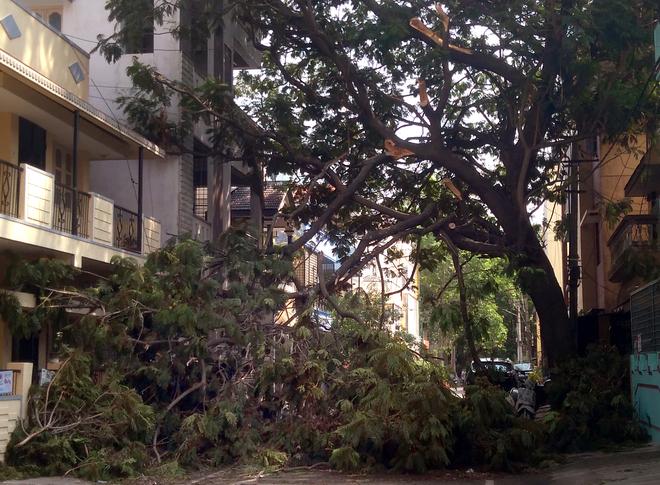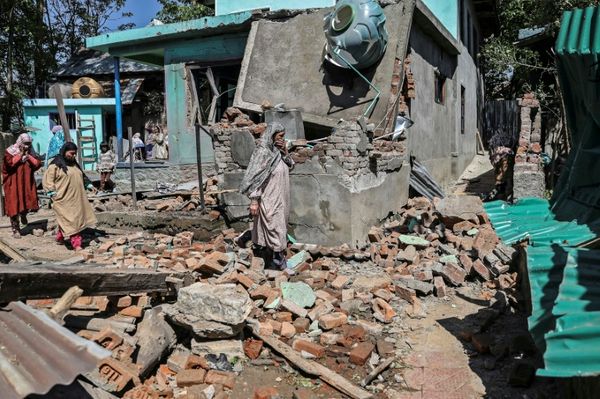Following an extended period of drought lasting over five months, Bengaluru received its first spell of rain on May 6. Intermittent showers have continued in the following days, resulting in the inundation of several roads. What has been a matter of particular concern is the uprooting of trees and the breaking of branches, which is usually expected during the monsoon season.
How many trees
According to data provided by the Bruhat Bengaluru Mahanagara Palike (BBMP), from May 6 to May 15, complaints of close to 331 uprooted trees, and a total of 664 fallen branches were received by the civic body following pre-monsoon rains. The highest number of complaints about fallen trees was 92, from the R.R. Nagar zone and the lowest was from Dasarahalli with 11 complaints, till May 15.
Speaking to The Hindu, BBMP’s Special Commissioner for Forest and Estates, Preeti Gehlot, said that the civic body is finding it difficult to understand why trees are getting uprooted. “While the tree uprooting cases are a few, it is mostly branches of trees that are falling or breaking due to rains. In the dry season, the tree canopy management goes on. Branches that are likely to break due to rain or based on complaints raised by public are trimmed. However, there are many trees that look very healthy from the outside but are not on the inside. It is difficult to understand and judge the health of the tree and predict which tree might fall, we are trying to understand why the felling of trees or breaking of branches are happening,” she said.
What handbook says
Experts say that rapid concretisation and urbanisation are the major causes for the deteriorating health of Bengaluru’s green life. According to the Urban Forestry Handbook by Bangalore Political Action Committe (B.PAC) that has been curated by inputs from tree experts from across the country, old Bengaluru was renowned for its expansive roads lined with avenue trees. Adjacent to these roads were broad parallel footpaths that accommodated tree planting, alongside stormwater drains positioned further out. Beyond these drains lay entrances and gates to buildings. However, with development and road widening, buildings came closer. This, coupled with a population surge, rapid urbanisation, and haphazard land-use planning during Bengaluru’s IT boom in the 1990s, has led to a significant reduction in green spaces within the city. Research conducted by the Indian Institute of Science (IISc) revealed a 66% decline in vegetated cover in Bengaluru as of 2012.
Vijay Nishanth, a contributor to the Urban Forestry Handbook, founder of Vruksha, and a tree expert, also known as “tree doctor” says the reason for trees getting uprooted in Bengaluru is concretisation and low maintenance of the health of the trees spread across the city.

Inappropriate works
“In old Bengaluru, like the 80s, the trees were planned and planted appropriately. However, haphazard urban growth has started affecting the trees. Inappropriately planned civic work like construction of drainage systems have led to cutting of tree roots. Concretisation of pavements has also affected the roots of the trees. Even the new trees planted over the last few years are falling, as they do not have enough root space. There is no coordination between the major civic bodies in the city, which is leading to the felling of the trees. The BBMP must release a manual or a notice, which explains how much space must be left around a tree wherever infrastructure is being built,” he says.
Nishanth says that another reason for trees breaking or uprooting frequently is bad maintenance. “Most trees in Bengaluru look healthy with a nice-looking canopy, but many die soon due to infections on the inside, it is the root that is weak or infected. The root health of the tree must be checked and maintained frequently to ensure the tree life sustains longer,” Nishanth adds.
The Urban Forestry Handbook says Under India’s National Forest Policy, 2018, which is aligned with COP21 climate action goals, India had declared that a third of the land area in India will be forested by 2030. Similarly, the Karnataka State Tree Cover Enhancement Policy of 2016 had set a goal of 33% land for state-wide tree cover, but in Bengaluru, there is no land-use based target for forestry. The book mentions research by Dr. T. V. Ramachandra and team at IISc that states that to ensure one tree per person and maintain some vital ecosystem services, Bengaluru must follow national and state goals, aiming to achieve 33% of urban forest cover in the city.
What trees to choose
Experts who have contributed to the book say that streets and public space availability for tree planting is low in Bengaluru. Choosing species with a tap root system or using a root barrier can help contain roots in a narrow space and push them deeper into the ground rather than wide. This ensures that roots can grow without disturbing surrounding buildings, roads, or footpaths, and the trunks grow upright as well, not obstructing road space. Selecting varieties with the correct height and without a wide crown can also help accommodate them in narrow spaces.
Naturist and a regular conductor of tree walks, Kavya Chandra, the founder of A Green Venture, says planting of native trees with enough breathing space is more sustainable. “The unusual uprooting of trees during the pre-monsoon period is due to the roots weakening and not having enough space to grow. All trees need a circumference of 2 to 5 feet depending on the type, and regular care and maintenance. We need to understand the types of trees that will sustain the conditions of Bengaluru.”
According to Chandra, exotic trees like Gulmohar, Copper Pod, Tabebuia grow well in Bengaluru. Many of the ornamental trees that have been brought to the city from various countries have adapted to the conditions of Bengaluru over the last 200 years. “Native trees like Pongamia (Honge), Bauhinia tree (Camel foot), the Muntinga Calabura tree (Singapore Cherry), Indian Almond tree (Jungli Badam) and smaller trees like neem, lime, curry leaf and guava will last longer, if they are given space and de-cemented around the base so the roots can breathe and don’t get choked,” says Chandra.







